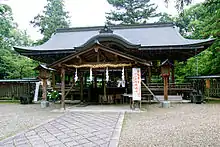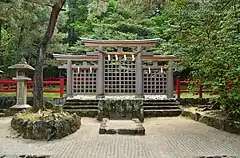| Yamato Okunitama | |
|---|---|
 The Haiden, or main prayer hall or Oyamato Shrine where he is worshipped | |
| Major cult centre | Ōyamato Shrine Yamato Okunitama Shrine |
Yamato Okunitama (Japanese: 倭大国魂神) is a kami, the okunitama (国魂; 'country spirit') or tutelary deity of Yamato Province.[1]
They are the ujigami, or 'clan deity', of the Yamato clan, and are worshiped at Ōyamato Shrine.[1] Some scholars interpret the kami as being a variant or epithet of Ōmononushi.[2]
As the Yamato court grew in power, shrines were constructed in more and more places beyond Yamato Province.[4]: 22
The scholar Hirata Atsutane said that the deities who were subjects of morning prayer within Yamato province were Yamato Okunitama, Ōmononushi, and Kotoshironushi.[5]: 343
Yamato Okunitama appears in the Nihon Shoki,[6] as well as the Kogo Shūi.[7] He was formerly worshiped in the imperial palace,[8] but Amaterasu was ultimately promoted over him when Emperor Sujin was disturbed by the presence of two competing kami'.[9] [10][11][6] This may be the ultimate reason that Amaterasu is considered to be the main deity of Shinto today.[9] Another interpretation is that Amaterasu's influence actually suffered as a result of this, as the center of her cult moved from the imperial palace to more diffuse locations, culminating in Ise.[2]
Mythical narrative
Yamato Okunitama is prominent in the Nihon Shoki's myths set during reign of Emperor Sujin.[12]

In the Nihon Shoki, Amaterasu, via the Yata-no-Kagami and the Kusanagi sword, and Yamato Okunitama were originally worshiped in the imperial palace's great hall.[12] Similar events also covered by the Kogo Shūi.[7]
The narrative relates that pestilence struck during the 5th year of Sujin's rule, and ultimately killed half of the Japanese population. Peasants abandoned their fields in the following year, and rebellion became rampant.[13] To relieve the suffering of his people, the emperor turned his attention towards the gods. At the time both Amaterasu, the sun goddess, and Yamato Okunitama were enshrined at the imperial residence. Sujin became overwhelmed with having to cohabit with these two powerful deities, and set up separate housings for them. Amaterasu was moved to a village named Kasanui in Yamato Province, where a himorogi altar was built out of solid stone.[13][lower-alpha 1] Sujin placed his daughter Toyosukiiri-hime in charge of the new shrine, where she would become the first Saiō,[15]entrusted with her the mirror and sword, she brought them to the village of Kasanuhi.[12][7] Meanwhile, Yamato Okunitama was entrusted to another daughter named Nunaki-iri-hime, but shortly afterwards, her health began to fail. It is recorded that she became emaciated and lost all of her hair, which rendered her unable to perform her duties.[13] These efforts still did not alleviate the ongoing plague, so Sujin decreed that a divination be performed sometime during the 7th year of his reign, that would involve him making a trip to the plain of Kami-asaji, and invoking the eighty myriad deities.[13] This mode of worship is seen as being potentially linked to a social order of greater complexity, and the organization of the deities of the many clans across the region.[16]
After these events, the Nihon Shoki narrative continues that Sujin's aunt Yamatototohimomoso-hime (倭迹迹日百襲媛命), the daughter of the seventh emperor Kōrei, acted as a shrine maiden, and was possessed by a god who identified himself as Ōmononushi,[13][2] possibly the same entity as Yamato Okunitama. Ichishi no Nagaochi would conduct the rites pertaining to Okunitama, replacing the emaciated Nunaki-iri-hime.[2] Ichishi no Nagaochi would be the ancestor of the Yamato clan.[17] This replacement is taken as a shift towards a more patriarchal religion.[2] This god claimed responsibility for the plague, announcing that it would not stop until he was venerated. Although the emperor propitiated to the god, the effects were not immediate. Sujin was later given guidance in the form of a dream to seek out a man named Ōtataneko and appoint him as head priest.[13] He eventually found him in Izumo Province.[2] When he was found and installed, the pestilence eventually subsided, allowing five cereal crops to ripen.[13] Out of an abundance of caution, the Emperor also appointed Ikagashikoo (伊香色雄) as kami-no-mono-akatsu-hito (神班物者), the 'one who sorts the offerings to the gods'.[18] To this day the Miwa sect of the Kamo clan still claims descent from Ōtataneko, while Ikagashikoo was a claimed ancestor of the now extinct Mononobe clan.[18]
Notes
- ↑ During the reign of Sujin's successor Suinin, custody of the sacred treasures were transferred from Toyosukiirihime to Suinin's daughter Yamatohime, who took them first to "Sasahata in Uda" to the east of Miwa. Heading north to Ōmi Province, she then traveled eastwards to Mino, then south to Ise, where she received a revelation from Amaterasu:
Now Ama-terasu no Oho-kami instructed Yamato-hime no Mikoto, saying:—"The province of Ise, of the divine wind, is the land whither repair the waves from the eternal world, the successive waves. It is a secluded and pleasant land. In this land I wish to dwell." In compliance, therefore, with the instruction of the Great Goddess, a shrine was erected to her in the province of Ise. Accordingly an Abstinence Palace was built at Kaha-kami in Isuzu. This was called the palace of Iso. It was there that Ama-terasu no Oho-kami first descended from Heaven.[14]
This account serves as the origin myth of the Grand Shrine of Ise, Amaterasu's chief place of worship.
References
- 1 2 "International Symposium "Perspectives on Japanese history and literature from ancient historical records"". Top Global University Project: Waseda Goes Global. Retrieved 2023-05-04.
- 1 2 3 4 5 6 Ellwood, Robert S. (1990). "The Sujin Religious Revolution". Japanese Journal of Religious Studies. 17 (2/3): 199–217. ISSN 0304-1042. JSTOR 30234018.
- ↑ Ellwood, Robert S. (1990). "The Sujin Religious Revolution". Japanese Journal of Religious Studies. 17 (2/3): 199–217. ISSN 0304-1042. JSTOR 30234018.
- 1 2 Hardacre, Helen (2017). Shinto: A History. Oxford University Press. ISBN 978-0-19-062171-1.
- ↑ Hardacre, Helen (2017). Shinto: A History. Oxford University Press. ISBN 978-0-19-062171-1.
- 1 2 "Book V", Nihongi: Chronicles of Japan from the Earliest Times to A.D. 697, Volume 1, retrieved 2023-05-04
- 1 2 3 Kogoshūi: Gleanings from Ancient Stories. Translated with an introduction and notes. Translated by Katō, Genchi; Hoshino, Hikoshirō. Meiji Japan Society. 1925. pp. 29–30.
- ↑ "The History of Infectious Disease in Japan: Origins of the World's Best Hygiene Awareness — The Mysterious Relationship between the Japanese and the God of Pestilence - Discuss Japan". www.japanpolicyforum.jp. Retrieved 2023-05-04.
- 1 2 D, John (2012-11-10). "Teeuwen on Shinto". Green Shinto. Retrieved 2023-05-04.
- ↑ https://www.japanpolicyforum.jp/pdf/2016/no35/DJweb_35_cul_02.pdf
- ↑ https://freidok.uni-freiburg.de/fedora/objects/freidok:4635/datastreams/FILE1/content
- 1 2 3 Aston, William George (1896). . Nihongi: Chronicles of Japan from the Earliest Times to A.D. 697. Kegan Paul, Trench, Trübner & Co. pp. – via Wikisource.
- 1 2 3 4 5 6 7 Aston, William George. (1896). Nihongi: Chronicles of Japan from the Earliest Times to A.D. 697, Volume 2. The Japan Society London. pp. 150–164. ISBN 9780524053478.
- ↑ Aston, William George (1896). . Nihongi: Chronicles of Japan from the Earliest Times to A.D. 697. Kegan Paul, Trench, Trübner & Co. pp. – via Wikisource.
- ↑ https://d-museum.kokugakuin.ac.jp/eos/detail/?id=8608
- ↑ "Contents", Himiko and Japan's Elusive Chiefdom of Yamatai, University of Hawaii Press, pp. 189–191, 2017-12-31, doi:10.1515/9780824862848-001, ISBN 978-0-8248-6284-8, retrieved 2023-10-24
- ↑ "Page:Nihongi by Aston.djvu/208 - Wikisource, the free online library". en.wikisource.org. Retrieved 2023-10-24.
- 1 2 Chamberlain, Basil. [SECT. LXV.—EMPEROR SŪ-JIN (PART III: STORY OF OHO-TATA-NE-KO'S BIRTH)] (The Kojiki). Read before the Asiatic Society of Japan on April 12, May 10, and June 21, 1882, reprinted in 1919. p. 219.
His Augustness Oho-tata-ne-ko ... was the ancestor of the Dukes of Miwa and of the Dukes of Kamo.
Bibliography
Nihon Shoki
See the references under Nihon Shoki for an extended bibliography
- Aston, William George (1896). Nihongi: Chronicles of Japan from the Earliest Times to A.D. 697. Vol. 1. London: Kegan Paul, Trench, Trubner (for the Japan Society of London). ISBN 9780524053478. OCLC 448337491., alt-link English translation
- JHTI (2002). "Nihon Shoki". Japanese Historical Text Initiative (JHTI). UC Berkeley. Retrieved 2019-08-23., searchtext resource to retrieve kanbun text vs. English tr. (Aston) in blocs.
- Ujiya, Tsutomu (宇治谷孟) (1988). Nihon shoki (日本書紀). Vol. 上. Kodansha. ISBN 978-0-8021-5058-5., modern Japanese translation.
- Chamberlain, Basil Hall (1919). The Kojiki. Kadokawa. OCLC 1882339. sacred texts
- Takeda, Yukichi (武田祐吉) (1977). Shintei Kojiki (新訂 古事記). Kadokawa. ISBN 4-04-400101-4., annotated Japanese.
Secondary sources
- Brown, Delmer M. and Ichirō Ishida, eds. (1979). Gukanshō: The Future and the Past. Berkeley: University of California Press. ISBN 978-0-520-03460-0; OCLC 251325323
- Nussbaum, Louis-Frédéric and Käthe Roth. (2005). Japan encyclopedia. Cambridge: Harvard University Press. ISBN 978-0-674-01753-5; OCLC 58053128
- Ponsonby-Fane, Richard Arthur Brabazon. (1959). The Imperial House of Japan. Kyoto: Ponsonby Memorial Society. OCLC 194887
- Titsingh, Isaac. (1834). Nihon Ōdai Ichiran; ou, Annales des empereurs du Japon. Paris: Royal Asiatic Society, Oriental Translation Fund of Great Britain and Ireland. OCLC 5850691
- Varley, H. Paul. (1980). Jinnō Shōtōki: A Chronicle of Gods and Sovereigns. New York: Columbia University Press. ISBN 978-0-231-04940-5; OCLC 59145842
.jpg.webp)
